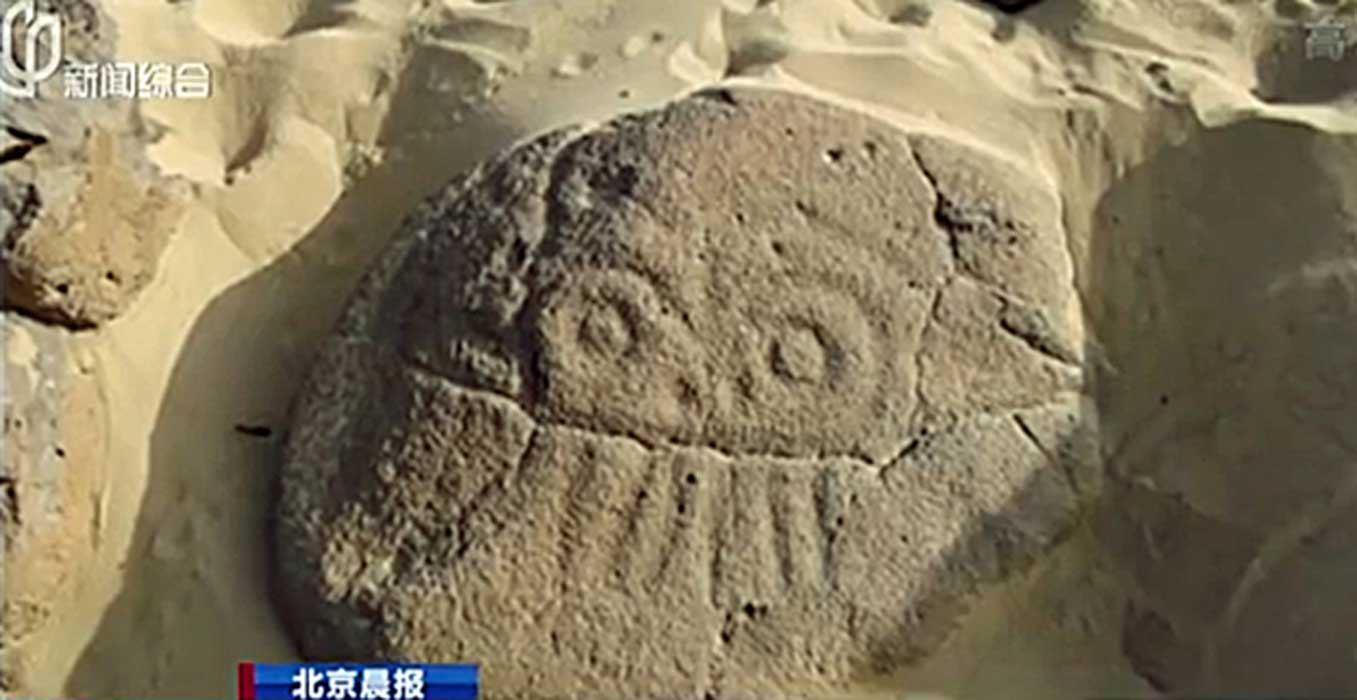Discovered! An Ancient Mongolian Stone Selfie!
Somewhere, deep in prehistory a human being gazed at their reflection in rock-pool, and was struck with an urge to carve what he saw. Subsequently, the first selfie was created! Now, in Inner Mongolia Autonomous Region, north China, a roughly 65 centimeters tall (25.6 inches) and 57 centimeters wide (22.5 inches), prehistoric human face has been found carved in sandstone which is believed to be over 7,000 years old.
New Rock Face
Professor Wu Jiacai, a rock painting scholar from Inner Mongolia Normal University, told reporters at ChinaDaily.com that his team ¨found the artifact during one of their field study missions at a sandy land east of Ongniud Bannar, Chifeng city, Xinhua.¨ The carved image has a pair of ¨symmetrical double cycle eyes, each of which is 18 centimeters in diameter (7.1 inches), a mouth and four vertical slits, perhaps meant to indicate teeth.¨
According to Wu, this newly-found portrait in stone is ¨larger and finer¨ with smooth lines and has ¨more protruding facial features compared to those found in the Russian Far East and other areas of Inner Mongolia.¨ While this particular stone carving is uniquely detailed and preserved, archaeologists in Inner Mongolia have discovered thousands of ancient engraved and chiseled human face rock paintings, all of which have a distinctive exaggerated expression style.
- The Mysterious Moche Icon of the Iguana, Companion to the Sky God Wrinkle Face
- Mysterious, Giant Face Found on Cliff in Canada—Man-Made or Natural?

Many other examples of faces have been found in Far East Russia and Mongolia. (Image: Inner Mongolia Daily)
Many Faces of Mongolia
Wu told reporters that "The human face rock paintings with different styles can provide materials to help studies on human migration and ethnic customs," and he noted that the carved faces were the "living fossils" of ancient human remains on the cliffs. This discovery will no doubt increase interest in the archaeology of Mongolia which is currently famous (archaeologically) for its Deer stones (also known as reindeer stones).
Deer Stones
These ancient standing stone megaliths are more modern than the latest face find at around 1000 BC and are decorated with a wide array of geometric carved symbols and animals, including a propensity of ´flying deer.´ Many theories exist attempting to explain what exactly these carvings represented, but nobody is quite sure who carved them and what they originally meant to their creators. A Natural History article detailed how these ´Deer stones´ were constructed from granite or greenstone and have varying heights; but most are between 1 meter (3 ft) and 5 meters (15 ft) tall.
- A Walk Amongst the Petroglyphs of Galicia: Prehistoric Designs Trace Life and Times of Bronze Age Europeans
- Climate Change and Looters Threaten the Archaeology of Mongolia

Deer Stones near Muren, Mongolia. These megaliths were carved with deer images at sometime around 1000 BC. (CC BY 2.0)
The tops of some of the stones are flattened and rounded, but many are smashed, distorting their original forms. Almost all of them are oriented with the decorated face to the east. The carved designs were pecked into the stone surface, and deep-grooved cuts and right-angle surfaces suggest metal tools were used for carving and a selection of unusually bored stones might have been cut with primitive mechanical drills.
Millennia of ‘Selfies’
Elsewhere in the ancient world, the earliest discovered ´carving,´ albeit not of a human form, was discovered on an engraved fresh water muscle shell at a site in eastern Java called Trinil in the 1890s by the Dutch palaeontologist Eugène Dubois, which dated to around 500,000 years ago. A Nature.com article detailed how the earliest human carved figures are probably the 70,000-year-old engraved ochre pieces found in the Blombos Cave of South Africa, and in Europe in 1892, archaeologist Édouard Piette discovered the ´La Dame de Brassempouy´ or ´The Venus of Brassempouy,´ in the Grotte du Pape at Brassempouy, France, a fragmented ivory human figurine dated to circa 24,000 to 22,000 BC.
- Finding the Legendary Mongolian Death Worm
- Monumental Mongolian Burial Discovered Includes 14 Giant Inscribed Pillars

Front and side view of the Venus of Brassempouy, circa 24000-22000 BC. (Public Domain)
And of course, the world of carved human forms is riddled with hoaxes and misinterpretations. For example, in 2001 archaeologist Pietro Gaietto led an expedition through the Borzonasca district of Italy and claimed to have found carved human forms dating to 200,000 years ago. "If I had not spotted it, it would have been covered in concrete and put into a wall," he told BBC News Online. Pietro Gaietto said the carving ¨shows two heads, facing outwards and joined at the neck. One of the faces is bearded; the other is beardless¨ and he said it would have been made by, ¨an extinct species of human called Homo erectus,¨ of which there was evidence in the region.
Mainstream scientists, however, believed these items were ¨not man-made at all¨ according to the BBC, and they argued that the, ¨distinctive features have very probably been molded by geological processes.¨
Top image: A prehistoric human face stone carving, which is believed to be over 7,000 years old, discovered in Inner Mongolia Autonomous Region, North China. Source: Youku Screenshot via GB Times
By Ashley Cowie



















